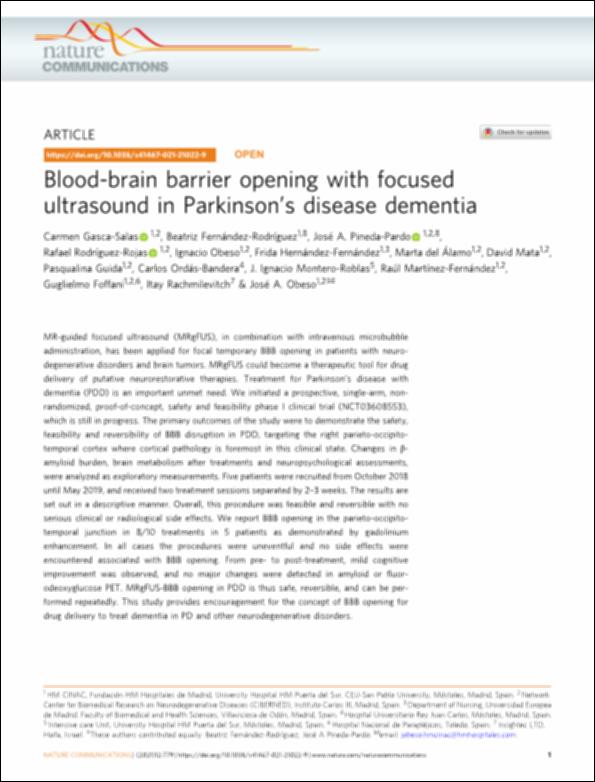Please use this identifier to cite or link to this item:
http://hdl.handle.net/10637/15325Blood-brain barrier opening with focused ultrasound in Parkinson’s disease dementia
| Title: | Blood-brain barrier opening with focused ultrasound in Parkinson’s disease dementia |
| Authors : | Gasca Salas, Carmen Fernández-Rodríguez, Beatriz Pineda-Pardo, José A. Rodríguez Rojas, Rafael Obeso Martín, Ignacio Hernández-Fernández, Frida Álamo, Marta del Mata-Marín, David Guida, Pasqualina Ordás Bandera, Carlos Montero Roblas, Juan Ignacio Martínez-Fernández, Raúl Foffani, Guglielmo Rachmilevitch, Itay Obeso Inchausti, José Ángel |
| Keywords: | MRgFUS; Intravenous microbubble administration; Neurodegenerative disorders; Brain tumors |
| Publisher: | Nature Research |
| Citation: | Gasca-Salas, C., Fernández-Rodríguez, B., Pineda-Pardo, J.A. et al. Blood-brain barrier opening with focused ultrasound in Parkinson’s disease dementia. Nat Commun 12, 779 (2021). https://doi.org/10.1038/s41467-021-21022-9 |
| Abstract: | MR-guided focused ultrasound (MRgFUS), in combination with intravenous microbubble administration, has been applied for focal temporary BBB opening in patients with neurodegenerative disorders and brain tumors. MRgFUS could become a therapeutic tool for drug delivery of putative neurorestorative therapies. Treatment for Parkinson’s disease with dementia (PDD) is an important unmet need. We initiated a prospective, single-arm, non-randomized, proof-of-concept, safety and feasibility phase I clinical trial (NCT03608553), which is still in progress. The primary outcomes of the study were to demonstrate the safety, feasibility and reversibility of BBB disruption in PDD, targeting the right parieto-occipito-temporal cortex where cortical pathology is foremost in this clinical state. Changes in β-amyloid burden, brain metabolism after treatments and neuropsychological assessments, were analyzed as exploratory measurements. Five patients were recruited from October 2018 until May 2019, and received two treatment sessions separated by 2–3 weeks. The results are set out in a descriptive manner. Overall, this procedure was feasible and reversible with no serious clinical or radiological side effects. We report BBB opening in the parieto-occipito-temporal junction in 8/10 treatments in 5 patients as demonstrated by gadolinium enhancement. In all cases the procedures were uneventful and no side effects were encountered associated with BBB opening. From pre- to post-treatment, mild cognitive improvement was observed, and no major changes were detected in amyloid or fluorodeoxyglucose PET. MRgFUS-BBB opening in PDD is thus safe, reversible, and can be performed repeatedly. This study provides encouragement for the concept of BBB opening for drug delivery to treat dementia in PD and other neurodegenerative disorders. |
| URI: | http://hdl.handle.net/10637/15325 |
| Rights : | http://creativecommons.org/licenses/by-nc-nd/4.0/deed.es OpenAccess |
| ISSN: | 2041-1723 |
| Issue Date: | 3-Feb-2021 |
| Center : | Universidad San Pablo-CEU |
| Appears in Collections: | Medicina |
Items in DSpace are protected by copyright, with all rights reserved, unless otherwise indicated.


